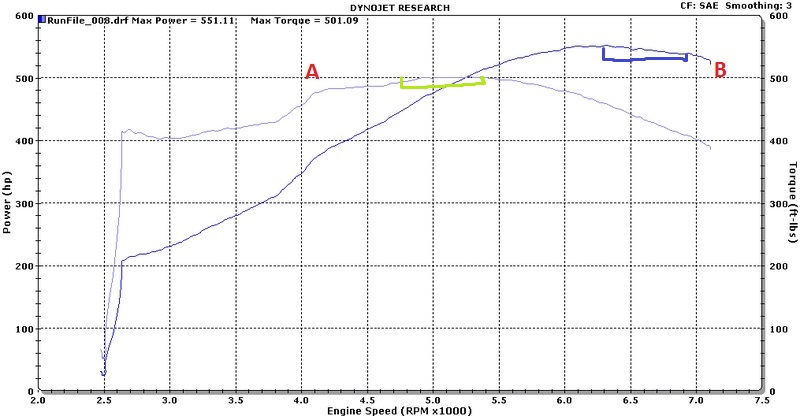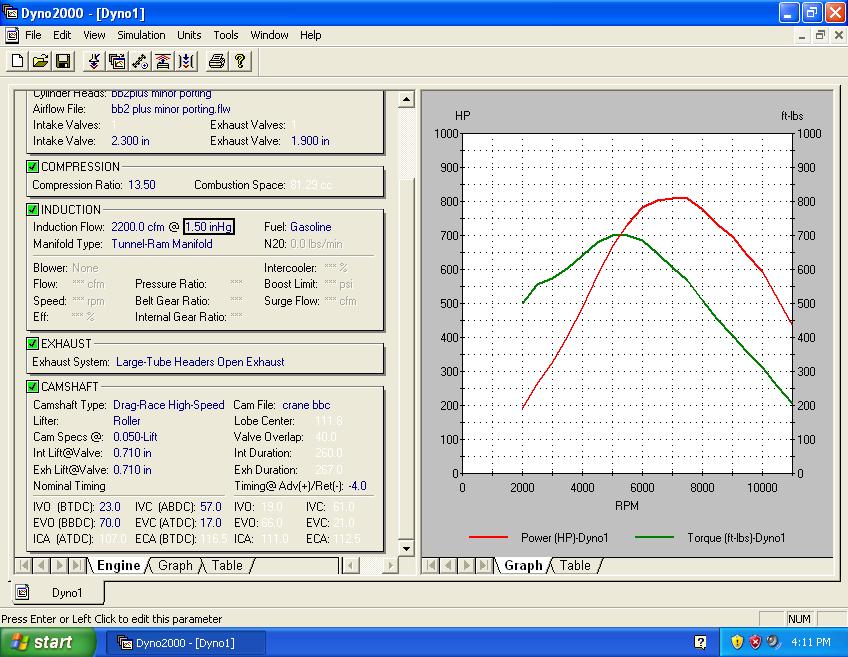now obviously it does you little good to sit and spin street tires,and your obviously limited by the cars wheel wheel clearances as to what will fit and function unless you tub the rear to gain significantly more clearance, and even a stock engine can more than likely spin stock street tires running the average 25-31 psi of air pressure on the hard street tire compounds, that are use on most cars, but once you start using a decent rear gear and a modified engine the problem becomes far worse, because of the increased power and you need to have an educated throttle foot to make decent 60 ft times on street tires, so unless you use slicks at the correct air pressure and have the suspension set up to handle the torque and shock loads, you need to learn how to control wheel spin,
now on most of my race cars I ran rather serious big block engines that would destroy even huge slicks if I launched at much over 2000rpm, but small block cars tend to require a minimum of about a 3000rpm launch and frequently a good deal higher rpms once your set up with slicks. once youve got the suspension and traction under control, you'll want to launch up near your engines torque peak rpm.
(1) YOU can control to a great degree the amount of torque your applying to the tires by controlling what your foot does on the throttle petal
(2) proper tires and suspension mods like modifying air pressure in the tires air shocks, traction bars etc.can be very useful but simply learning how to drive the car and how and when and at what rate you can apply power helps a great deal, that takes practice and experience.
Ive built and raced dozens of cars, each is unique and each takes a slightly different drive style, each car will require you to master its flaws and strengths and it makes little difference if its a 400hp street/strip car or a 700hp strip car, your knowledge of how to set up a suspension, recognize how the suspension and tires work together, and work with the cars limitations will make or break the combo to a large extent
viewtopic.php?f=71&t=372&p=454&hilit=physics+of+racing#p454
viewtopic.php?f=80&t=906&p=27083&hilit=learning+drive#p27083
viewtopic.php?f=50&t=248&p=295&hilit=needs+500hp#p295
viewtopic.php?f=87&t=5121&p=14750&hilit=launch+traction#p14750
related threads
viewtopic.php?f=80&t=906
viewtopic.php?f=71&t=555
viewtopic.php?f=71&t=555&p=1084&hilit=slicks#p1084
viewtopic.php?f=87&t=487&p=601&hilit=slicks#p601
viewtopic.php?f=87&t=486&p=600&hilit=launch+marks#p600
viewtopic.php?f=71&t=237&p=282&hilit=+slicks#p282
viewtopic.php?f=71&t=1282&p=13095&hilit=dana#p13095
viewtopic.php?f=71&t=447&p=2374&hilit=slicks#p2374
viewtopic.php?f=81&t=2617&p=6756&hilit=slicks#p6756
viewtopic.php?f=71&t=1934&p=5126&hilit=slicks#p5126
yes if you race your car eventually your going to break something and need a trailer to get home
viewtopic.php?f=27&t=845&p=11538&hilit=tires+wheels#p11538
there are now 17" slicks available ....but a serious power level and a dana 36 combined won,t be a good combo with slicks
http://moesperformance.com/index.php?ma ... s_id=12401
http://www.slickstyres.co.uk/dunlop.htm

keep in mind part of the idea here in this discussion,is to bring up factors for discussion, so guys reading thru this thread ,think thru the combo they build and how the drive train will effect the cars performance.

IF this really was the available power curve, I can assure you from experience shifts should all be made some ware in the blue part of the power band so you fall back into the green area of the rpm band, to maximize useable torque to move the car
in most cases , at least in theory, you look at the dyno results and you see the effective part of the torque curve falls between A & B you calculate where in that rpm band you can shift too each new gear so that your rpms only drop too a point in the rpm band just a bit higher than point A thus your always maximizing the torque curve potential, but because each gear change results in a slightly different drop in rpms the shift points also must vary, to match, lets say you decide that 4600rpm is your target sweet spot,you know the gear ratios so you figure where in the rpm band to shift so you fall back into 4600rpm in the power band. in reality you seldom have the gear ratio changes spaced close enough to do that so your forced to shift at or near to but a bit lower than the engines red line, and thus its common for the rpm levels to fall back a bit lower than the ideal.
red line or the rpm where your likely to start breaking parts due to increase stress and loss over valve train control obviously depends on components used and the engines stroke , but piston speeds of 4200fpm are fairly high and stock parts don,t normally play well much past that, and 4500fpm in piston speed even with good race parts seldom leads to long term durability.
RELATED INFO
viewtopic.php?f=53&t=343&p=1170&hilit=redline#p1170
then there's the distance traveled in each gear between those shifts and the need to keep the engine below redline going thru the lights at the end of the 1/4 mile, so you actually finish a race with the engine still in running condition.........when I was much younger standard operational thought was just stick a 4 speed in the car,launch the car using slicks , at the lowest rpm that still kept the race tires boiling as you left the starting line, use solid lifter cams , set the ignition rev limiter as high as you thought you could get away with, shift when you saw the tachometer, get near the rev limit, and use as large a tire as would fit in the fenders, add some traction bars and a 4.11:1 rear gear and go racing..... that approach seemed to work for most muscle cars at the time and 45 years of more advanced technology progressed the art, it was found to have a few flaws, in that basic concept.
now on most of my race cars I ran rather serious big block engines that would destroy even huge slicks if I launched at much over 2000rpm, but small block cars tend to require a minimum of about a 3000rpm launch and frequently a good deal higher rpms once your set up with slicks. once youve got the suspension and traction under control, you'll want to launch up near your engines torque peak rpm.
(1) YOU can control to a great degree the amount of torque your applying to the tires by controlling what your foot does on the throttle petal
(2) proper tires and suspension mods like modifying air pressure in the tires air shocks, traction bars etc.can be very useful but simply learning how to drive the car and how and when and at what rate you can apply power helps a great deal, that takes practice and experience.
Ive built and raced dozens of cars, each is unique and each takes a slightly different drive style, each car will require you to master its flaws and strengths and it makes little difference if its a 400hp street/strip car or a 700hp strip car, your knowledge of how to set up a suspension, recognize how the suspension and tires work together, and work with the cars limitations will make or break the combo to a large extent
viewtopic.php?f=71&t=372&p=454&hilit=physics+of+racing#p454
viewtopic.php?f=80&t=906&p=27083&hilit=learning+drive#p27083
viewtopic.php?f=50&t=248&p=295&hilit=needs+500hp#p295
viewtopic.php?f=87&t=5121&p=14750&hilit=launch+traction#p14750
related threads
viewtopic.php?f=80&t=906
viewtopic.php?f=71&t=555
viewtopic.php?f=71&t=555&p=1084&hilit=slicks#p1084
viewtopic.php?f=87&t=487&p=601&hilit=slicks#p601
viewtopic.php?f=87&t=486&p=600&hilit=launch+marks#p600
viewtopic.php?f=71&t=237&p=282&hilit=+slicks#p282
viewtopic.php?f=71&t=1282&p=13095&hilit=dana#p13095
viewtopic.php?f=71&t=447&p=2374&hilit=slicks#p2374
viewtopic.php?f=81&t=2617&p=6756&hilit=slicks#p6756
viewtopic.php?f=71&t=1934&p=5126&hilit=slicks#p5126
yes if you race your car eventually your going to break something and need a trailer to get home
viewtopic.php?f=27&t=845&p=11538&hilit=tires+wheels#p11538
there are now 17" slicks available ....but a serious power level and a dana 36 combined won,t be a good combo with slicks
http://moesperformance.com/index.php?ma ... s_id=12401
http://www.slickstyres.co.uk/dunlop.htm
keep in mind part of the idea here in this discussion,is to bring up factors for discussion, so guys reading thru this thread ,think thru the combo they build and how the drive train will effect the cars performance.

IF this really was the available power curve, I can assure you from experience shifts should all be made some ware in the blue part of the power band so you fall back into the green area of the rpm band, to maximize useable torque to move the car
in most cases , at least in theory, you look at the dyno results and you see the effective part of the torque curve falls between A & B you calculate where in that rpm band you can shift too each new gear so that your rpms only drop too a point in the rpm band just a bit higher than point A thus your always maximizing the torque curve potential, but because each gear change results in a slightly different drop in rpms the shift points also must vary, to match, lets say you decide that 4600rpm is your target sweet spot,you know the gear ratios so you figure where in the rpm band to shift so you fall back into 4600rpm in the power band. in reality you seldom have the gear ratio changes spaced close enough to do that so your forced to shift at or near to but a bit lower than the engines red line, and thus its common for the rpm levels to fall back a bit lower than the ideal.
red line or the rpm where your likely to start breaking parts due to increase stress and loss over valve train control obviously depends on components used and the engines stroke , but piston speeds of 4200fpm are fairly high and stock parts don,t normally play well much past that, and 4500fpm in piston speed even with good race parts seldom leads to long term durability.
RELATED INFO
viewtopic.php?f=53&t=343&p=1170&hilit=redline#p1170
then there's the distance traveled in each gear between those shifts and the need to keep the engine below redline going thru the lights at the end of the 1/4 mile, so you actually finish a race with the engine still in running condition.........when I was much younger standard operational thought was just stick a 4 speed in the car,launch the car using slicks , at the lowest rpm that still kept the race tires boiling as you left the starting line, use solid lifter cams , set the ignition rev limiter as high as you thought you could get away with, shift when you saw the tachometer, get near the rev limit, and use as large a tire as would fit in the fenders, add some traction bars and a 4.11:1 rear gear and go racing..... that approach seemed to work for most muscle cars at the time and 45 years of more advanced technology progressed the art, it was found to have a few flaws, in that basic concept.

